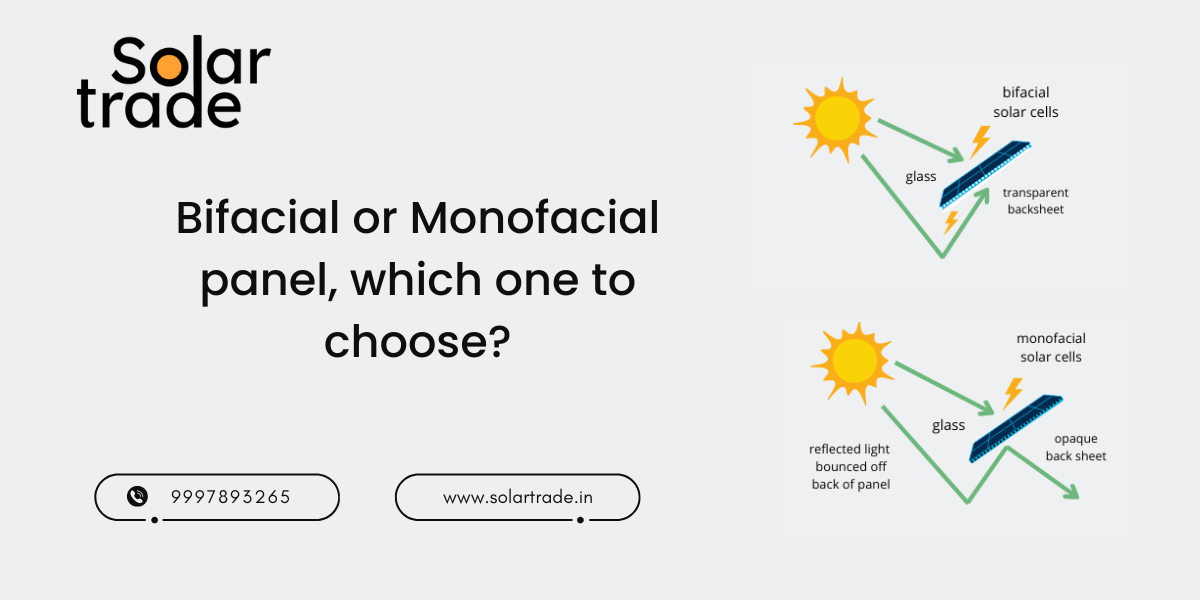
What is the difference between Bifacial and Mofacial solar panels?
Solar panels have experienced numerous modifications since their inception. With technological innovation, a new type of solar panel, bifacial panels, has already hit the market. We have poly and mono crystalline solar panels and now we have monofacial and bi-facial solar panels.
Now as a solar consumer, you must be thinking about what is bifacial and what is monofacial and which one you should choose. But don’t worry, at Solartrade, we are going to help you choose the perfect solar panel for your solar power plant. In this article we have tried to explain you what is the difference between bifacial and monofacial solar panels.
Let’s start with understanding what are monofacial and bifacial solar panels.
What are monofacial solar panels?
Monofacial solar panels are the most common type of solar panel, containing solar cells on only one side. They capture solar energy from one photovoltaic side and convert it to electrical energy to power electronic devices.
The vast majority of solar panels on the market are monofacial modules. In other words, these solar panels are far more popular than bifacial modules.
What are the advantages of monofacial solar panels?
The following are the benefits of monofacial solar panels:
- Solar panels are generally pricey. However, when compared to bifacial panels, monofacial modules are less expensive.
- They are also easier to install. Because they only catch light from one side, they are less expensive in theory and practice than bifacial modules.
- Another advantage of monofacial solar panels is that they are less expensive than bifacial panels. The monofacial solar panels are lighter than their predecessors since there are no solar cells on the rear side.
- Monofacial solar panels may operate on any surface and do not require a reflective surface to function. This feature contributes to the cheaper cost of solar panels.
What are bifacial solar panels?
Instead of a rear sheet like monofacial solar panels, bifacial solar panels have a transparent back sheet that allows both sides of the panel to capture sunlight.
This enables the panels to absorb not just direct sunlight but also reflected light. It is usually only used on tiled racking systems or ground bifacial solar mounting systems because they create more energy when the rear side of the panel can absorb more reflected light. The higher the bifacial module is inclined, the more power the bifacial panels create.
Bifacial panels are less common than monofacial modules. Probably because they are newer and hence more expensive.
The good news is that the Indian market is transitioning towards using bifacial technology due to its great efficiency and high energy-generating capacity.
What are the benefits of bifacial solar panels?
- The bifacial panels have an efficiency of 11-12% more than the conventional panels. These panels are more efficient than monofacial modules because they produce more energy with fewer resources.
- Bifacial modules, as opposed to monofacial panels, are more durable. They do not crack in harsh weather conditions. They are also heat resistant.
- Installation requires less area than monofacial solar panels. This is because it takes fewer bifacial modules to create the same quantity of power as many monofacial solar panels.
- Another advantage is that the bifacial panels can be installed at any angle. You are not required to assess or calculate the proper mounting and tilt angle for their installation.
- They do not require trackers to function. If you’re wondering what a tracker is, it’s a piece of equipment that adjusts the angles of solar panels. They also come with a 30-year warranty.
Now the question is which solar panel is best for you, well the answer is with you. You need to know what is your energy requirements and how much space you have. If your energy requirement is more in comparison to the space you have, then you should go with bifacial solar panels.
The design of the structure plays a very important role, if there is no space for sunlight to bounce back to the backside of the bifacial solar then there is no use for bifacial.
So our suggestion is for you to consult the solar installer, and get professional help.